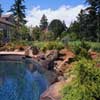Where to Put a Retaining Wall
Retaining walls are used for a variety of reasons. They can serve practical purposes like marking a property line or creating privacy; or they can be used purely for aesthetics. Materials used for retaining walls include brick, stone, wood, concrete and adobe. Keep your wall consistent with the style of your house or garden, including complementing materials. The goal should be to integrate your wall into your landscape.
 Decide if you want a formal or informal wall, what its purpose is, what style you want, material, etc. After these decisions have been made, think about location. If you have a patio or deck that is very visible from your neighbor's yard, consider building a wall to create privacy. The same would be a good idea if you have a spa in your yard.
Decide if you want a formal or informal wall, what its purpose is, what style you want, material, etc. After these decisions have been made, think about location. If you have a patio or deck that is very visible from your neighbor's yard, consider building a wall to create privacy. The same would be a good idea if you have a spa in your yard.
If you have a sloping yard, installing a low, wall could separate levels; and stairs could be added as an interesting feature in your yard. Flowers and plants can be planted above the wall and this can create a beautiful, natural look.
Enclosing an area of your yard or garden with a low, wall breaks up the yard and sections off the area. A private eating nook, a prized rose garden, a pond or whatever you want.
Remember that walls over three feet high require reinforcement and special forming. It would be smart to hire a contractor to help with any wall over this limit. Also, be sure to provide drainage. This is essential.
-- Tips courtesy of HomeAdvisor.com